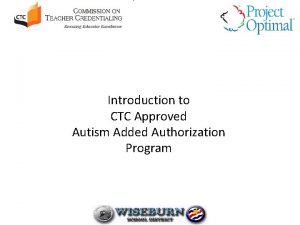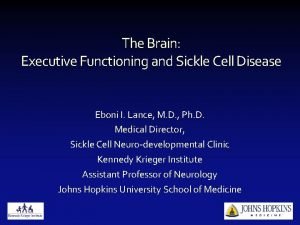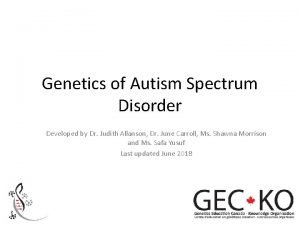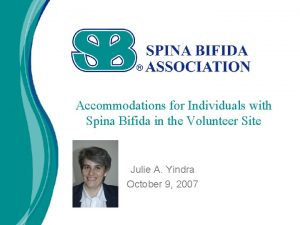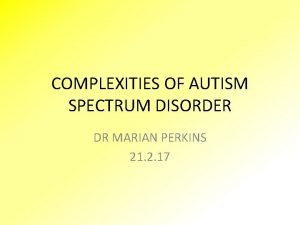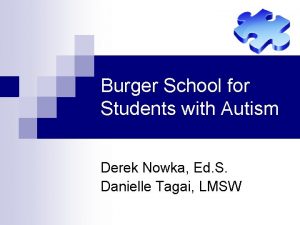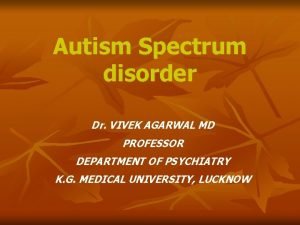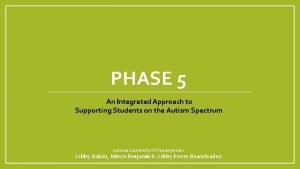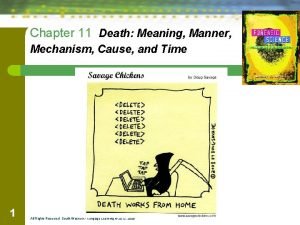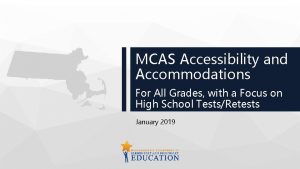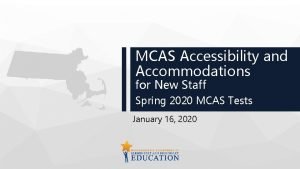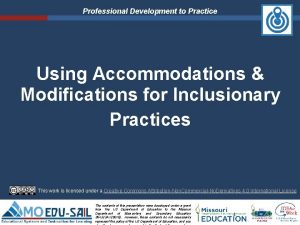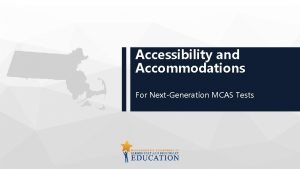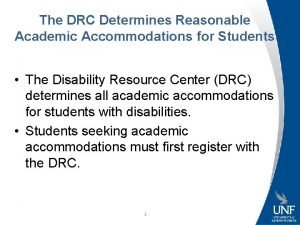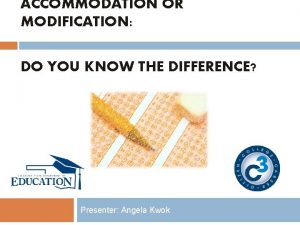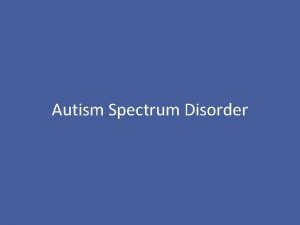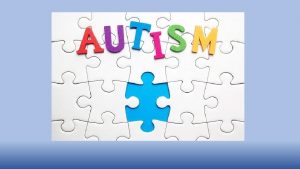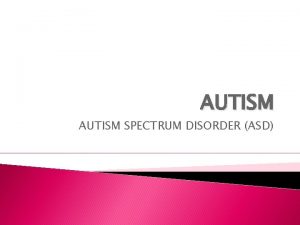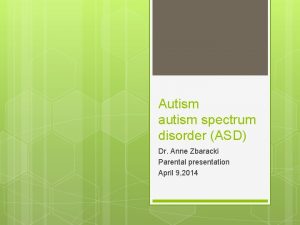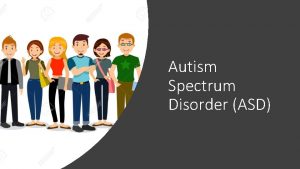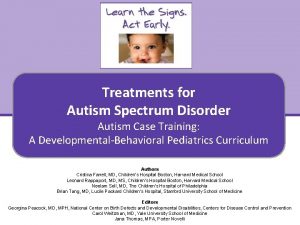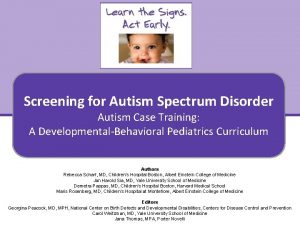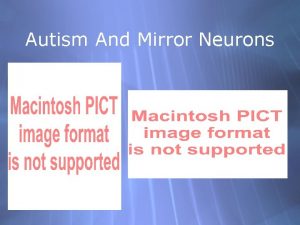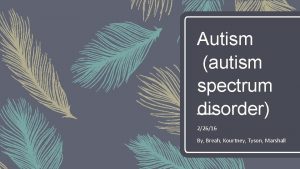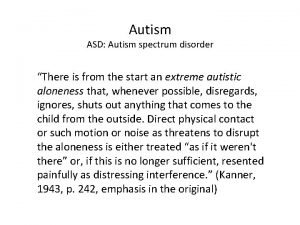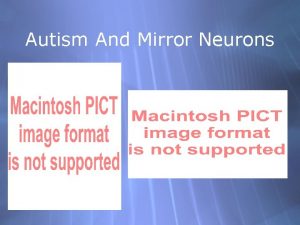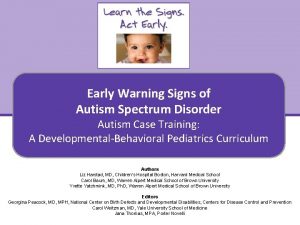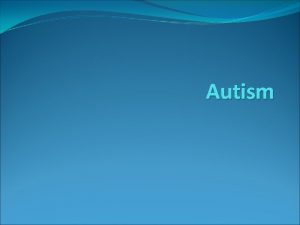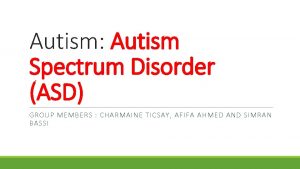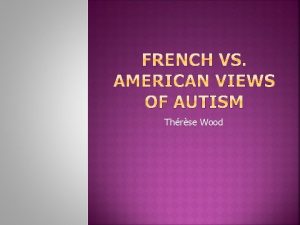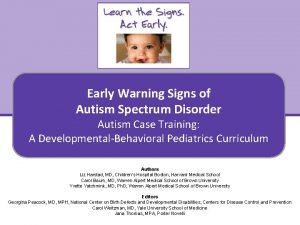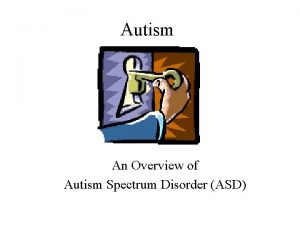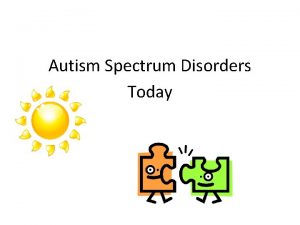Accommodations for Students with Autism Spectrum Disorder K






















- Slides: 22

Accommodations for Students with Autism Spectrum Disorder. K. Mark Derby, Ph. D. Gonzaga University

Teaching Specific • I m not going to focus on social skills application • I am going to focus on what I recommend to teachers for instruction.

What is Autism? • According to the American Psychiatric Association (APA): – Severe qualitative impairment in: • Reciprocal interaction (i. e. , doesn’t have intuitive ability to socialize) • Verbal and nonverbal communication – Restricted range of activities and interests

DSM-V • A. Persistent deficits in social communication and social interaction across multiple contexts, as manifested by the following, currently or by history (examples are illustrative, not exhaustive, see text): • 1. Poor social-emotional reciprocity • 2. Deficits in nonverbal communicative behaviors • 3. Difficulties adjusting behavior to suit various social contexts. • imaginative play • making friends • absence of interest in peers.

DSM-V B. Restricted, repetitive patterns of behavior, interests or activities: • 1. Stereotyped or repetitive motor movements, use of objects, or speech. • 2. Insistence on sameness, inflexible. adherence to routines, or ritualized patterns or verbal nonverbal. • 3. Highly restricted, fixated interests that are abnormal in intensity or focus. • 4. Hyper- or hypo reactivity to sensory input or unusual interests in sensory aspects of the environment.

Severity Level 3: Requiring very substantial support Typically severe to profound developmental impairment and all of the comorbid problems Level 2: Requiring substantial support Typically moderate developmental impairment. Limited Verbal. Taught to routine. Level 1: Requiring Support Typically Mild to borderline developmental level. Verbal and most underserved.

Where do we serve Level 3: Self-contained with minimal integration. Level 2: Self-contained with integration in appropriate classes. Level 1: Extended resource, behavior disorder classrooms, or 504

I will focus on Level 1 today • Why: That is the group that is least understood and served. • Will attempt to link to the DSM Symptoms. • I will discuss what I have seen work.

Poor social-emotional reciprocity Inability to recognize and understand others’ thoughts, beliefs, intentions. Implication: Over or under approach. Push right in or never initiate. Outcome: Will be in constant trouble with peers or you will not know they are there. Accommodation: Provide a context for conversation.

Provide the context for conversation • Power cards for typical conversational situations (read the paper) • Advanced home work to take away the need to think and be social a the same time (make them the kid with the answers)

Deficits in nonverbal communicative behaviors Implication: Always a step behind because we communicate using verbal words and pragmatics. Outcome: Will not pick up the teaching ques. Accommodation: Remove the need for the cue.

Provide the cues • Guided Notes with direct instruction. • Highlighted notes of specific key points. • Ensure that areas in the written text and are important are provided. • Bottom line: Remove all implicit instruction and make it explicit.

Difficulty adjusting behavior to suit various social contexts. Implication: No recognition too inappropriate recognition. Poor friendships. Bully? Outcome: A constant state of the world misunderstanding what they are communicating to us. Poor friendships. Bully? Accommodation: Providers must have it role off, provide alternative opportunities to respond. Remember the disability is a disability of social behavior.

Alternative opportunities to respond. • Wait to respond to the students actions. • For example: Playground problems/bullyingthey will not be able to respond effectively without facilitation and time. • Always give them time to think and restate: “I hate this school, I could blow it up. ” Treat this the same as a kid that is suicidal. Do you have a plan

Stereotyped or repetitive motor movements, use of objects, or speech • Not a typical concern for Severity 1 students • Biggest issue: If it does not interfere with education do not intervene. Punishment induced aggression. • Severity 2 and 3: Main thing to remember the need to use satiation and deprivation in your favor.

sameness, inflexible, ritualized Inability to adjust to environmental change Implication: At best, increased level of anxiety. At worst, severe behavior. Outcome: Systematic permissive consequences. Accommodation: Provide structure in a unstructured environment.

restricted, fixated interests Inability to adjust to environmental change Implication: Not able to accept alternative topics. Outcome: Noncompliance, severe behavior Accommodation: Adjust the assignment to tap into interests, get to the point (can the student use rote learning of facts)

restricted, fixated interests • Attempt to take away the added stress of social engagement and alternative interests (Advanced key points and home work) • For key subject like math, reading and writing. Is it the topic or the skill we are teaching (why that book) • Allow within the Premack Principle

Examples • Fixated rules: I do not get out of my seat. Out of batteries? Cannot get up • Basic Skill of reading fluency. Can they do a Read Naturally context with Star Wars Premack This-then-that (Life does not last forever)

Sensory Hyper- or Hyporeactivity Inability to adjust to environmental change Implication: Either seeking sensory or avoiding sensory Outcome: Either way will lead to disruption of classroom routines if we let it. Accommodation: Seeking: Appropriate Activity, Sensory Breaks, Use satiation for your benefit. Avoiding: Communication is honored, Avoid the Overload.

Provide accomodations with this in mind. Simplify the work into discrete demands. Avoid multiple senses working at once. Provide consistent rules. Pause, Pause. There is a disconnect with what is said and what is meant. • Safety through structure. • • •

Questions
 Autism spectrum disorders added authorization
Autism spectrum disorders added authorization Autism spectrum disorder adhd
Autism spectrum disorder adhd Types of autism spectrum disorder dsm 5
Types of autism spectrum disorder dsm 5 Cdd disorder
Cdd disorder Spectrum disorder
Spectrum disorder Accommodations for students with spina bifida
Accommodations for students with spina bifida Social pragmatic communication disorder vs autism
Social pragmatic communication disorder vs autism Puberty and autism spectrum disorders
Puberty and autism spectrum disorders Somatic symptom disorder vs factitious disorder
Somatic symptom disorder vs factitious disorder Burger school for students with autism
Burger school for students with autism Spectrum disorder
Spectrum disorder Spectrum disorder
Spectrum disorder Fetal alcohol spectrum disorder
Fetal alcohol spectrum disorder Copper orbital diagram
Copper orbital diagram Absorption spectrum
Absorption spectrum How jose become the champion of filipino student?
How jose become the champion of filipino student? Human read aloud mcas
Human read aloud mcas Mcas accommodations
Mcas accommodations Types of accommodations
Types of accommodations Usmle accommodations personal statement
Usmle accommodations personal statement Mcas accessibility and accommodations
Mcas accessibility and accommodations Drc accommodations
Drc accommodations Difference in accommodations and modifications
Difference in accommodations and modifications
